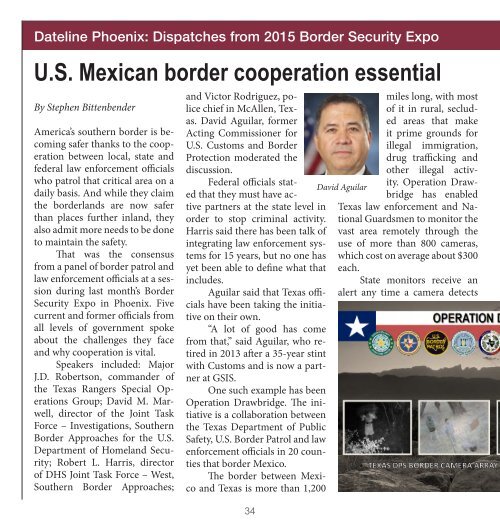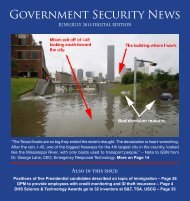Government Security News April May 2015
You also want an ePaper? Increase the reach of your titles
YUMPU automatically turns print PDFs into web optimized ePapers that Google loves.
Dateline Phoenix: Dispatches from <strong>2015</strong> Border <strong>Security</strong> Expo<br />
U.S. Mexican border cooperation essential<br />
By Stephen Bittenbender<br />
America’s southern border is becoming<br />
safer thanks to the cooperation<br />
between local, state and<br />
federal law enforcement officials<br />
who patrol that critical area on a<br />
daily basis. And while they claim<br />
the borderlands are now safer<br />
than places further inland, they<br />
also admit more needs to be done<br />
to maintain the safety.<br />
That was the consensus<br />
from a panel of border patrol and<br />
law enforcement officials at a session<br />
during last month’s Border<br />
<strong>Security</strong> Expo in Phoenix. Five<br />
current and former officials from<br />
all levels of government spoke<br />
about the challenges they face<br />
and why cooperation is vital.<br />
Speakers included: Major<br />
J.D. Robertson, commander of<br />
the Texas Rangers Special Operations<br />
Group; David M. Marwell,<br />
director of the Joint Task<br />
Force – Investigations, Southern<br />
Border Approaches for the U.S.<br />
Department of Homeland <strong>Security</strong>;<br />
Robert L. Harris, director<br />
of DHS Joint Task Force – West,<br />
Southern Border Approaches;<br />
and Victor Rodriguez, police<br />
chief in McAllen, Texas.<br />
David Aguilar, former<br />
Acting Commissioner for<br />
U.S. Customs and Border<br />
Protection moderated the<br />
discussion.<br />
Federal officials stated<br />
that they must have active<br />
partners at the state level in<br />
order to stop criminal activity.<br />
Harris said there has been talk of<br />
integrating law enforcement systems<br />
for 15 years, but no one has<br />
yet been able to define what that<br />
includes.<br />
Aguilar said that Texas officials<br />
have been taking the initiative<br />
on their own.<br />
“A lot of good has come<br />
from that,” said Aguilar, who retired<br />
in 2013 after a 35-year stint<br />
with Customs and is now a partner<br />
at GSIS.<br />
One such example has been<br />
Operation Drawbridge. The initiative<br />
is a collaboration between<br />
the Texas Department of Public<br />
Safety, U.S. Border Patrol and law<br />
enforcement officials in 20 counties<br />
that border Mexico.<br />
The border between Mexico<br />
and Texas is more than 1,200<br />
34<br />
miles long, with most<br />
of it in rural, secluded<br />
areas that make<br />
it prime grounds for<br />
illegal immigration,<br />
drug trafficking and<br />
other illegal activity.<br />
Operation Drawbridge<br />
has enabled<br />
Texas law enforcement and National<br />
Guardsmen to monitor the<br />
vast area remotely through the<br />
use of more than 800 cameras,<br />
which cost on average about $300<br />
each.<br />
State monitors receive an<br />
alert any time a camera detects<br />
David Aguilar







